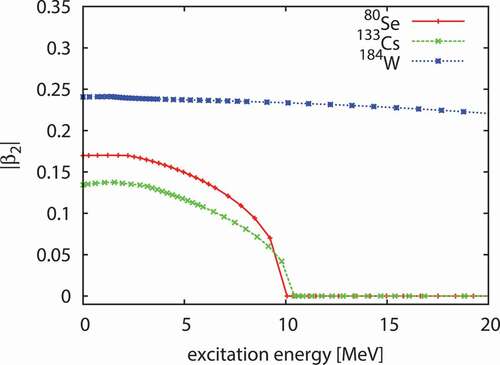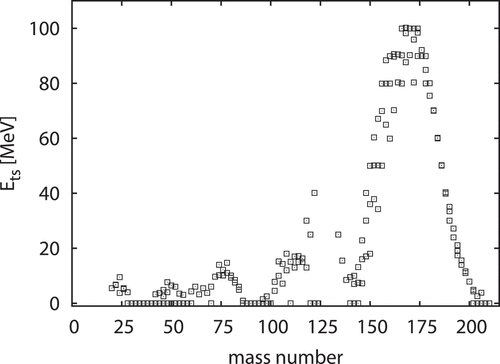 ?Mathematical formulae have been encoded as MathML and are displayed in this HTML version using MathJax in order to improve their display. Uncheck the box to turn MathJax off. This feature requires Javascript. Click on a formula to zoom.
?Mathematical formulae have been encoded as MathML and are displayed in this HTML version using MathJax in order to improve their display. Uncheck the box to turn MathJax off. This feature requires Javascript. Click on a formula to zoom.ABSTRACT
A phenomenological level density model that has different level density parameter sets for the state densities of the deformed and the spherical states and the optimization of the parameters using experimental data of the average s-wave neutron resonance spacing are presented. The transition to the spherical state from the deformed one is described using the parameters derived from a microscopic nuclear structure calculation. The nuclear reaction calculation has been performed by the statistical model using the present level density. Resulting cross sections for various reactions with the spherical, deformed, and transitional target nuclei show a good agreement with the experimental data, which indicates the effectiveness of the present model. The role of the rotational collective enhancement in the calculations of those cross sections is also discussed.
1. Introduction
The level density (LD) is a key ingredient in the nuclear reaction calculation using the statistical model. The accuracy of the calculated nuclear reaction observables for various reaction channels relies on the LD, and therefore, a number of theoretical works employing phenomenological [Citation1–Citation4] or microscopic models [Citation5–Citation11] have been devoted to achieve a reliable LD. While the microscopic models are basically free from adjustable parameters and suitable to predict LDs of nuclei away from the stability line, the phenomenological models that have analytical formula and adjustable parameters are still useful to calculate LDs of nuclei around the stability line for the practical applications. Generally, the reliability of the phenomenological models is ensured with the experimental information of excitation energies and spin-parity of the low-lying discrete states, and the average of the s-wave neutron resonance spacing .
One of the key effects for LD is the enhancement due to the collective nuclear excitations. It is theoretically indicated that the collective rotational excitation brings an extremely large enhancement on the LD, which amounts to 10–100 magnitude at the neutron threshold energy of stable nuclei [Citation4,Citation12]. Despite its huge effect, the phenomenological LD models without the explicit treatment of the collective enhancement have been successfully applied to the nuclear reaction calculations for practical uses, for example, the LD model of Gilbert and Cameron [Citation1] without the collective enhancement [Citation2] has been mainly used in the statistical model calculation of the neutron-induced reaction under 20 MeV for the nuclear data evaluation of Japanese Evaluated Nuclear Data Library (JENDL) [Citation13]. The reason why such a LD model does not cause serious problems in nuclear reaction calculations is conjectured that the collective enhancement is effectively taken into account in LD parameters, if they are optimized using the experimental [Citation2,Citation3].
Actually, such an effective LD model works well for the optimization of the asymptotic LD parameter to reproduce . Koning et al. [Citation3] have derived the global LD parameter systematics for the several LD models with and without explicit treatment of the collective enhancement. As for the Fermi gas-based models, both the collective and the effective LDs have a similar precision for the reproduction of
to each other.
It is noted that besides the phenomenological models discussed here, the importance of the explicit treatment of the collective excitation is rather obvious in the microscopic LD calculations using Hartree–Fock plus Bardeen–Cooper–Schrieffer (HF + BCS) theory with the partition function method [Citation6,Citation7], and Hartree–Fock–Bogiliubov (HFB) theory with the combinatorial method [Citation8–Citation11]. All these studies treated the collective excitation explicitly and found a reasonable agreement between the calculated and the experiments. These results indicate that if the intrinsic state densities are calculated without the parametrization, the collective enhancements are naturally required.
The role of the explicit treatment of the collective enhancement in phenomenological LD models can be discussed from nuclear reaction calculations. Koning et al. [Citation3] have applied the effective and the collective LD models to systematic calculations of the nuclear reactions. The calculated cross sections are systematically different between them for various reaction channels. The difference is expected to be more significant in a nuclear reaction at a higher incident energy, because the asymptotic behaviors of LD models with and without the collective enhancement are quite different. Actually, the important role of the collective enhancement in the cross section calculation for the projectile fragmentation with a relativistic incident energy has been reported [Citation14].
However, there remain problems in the description of the collective enhancement in phenomenological models. One is the fading of the collective enhancement as a function of the excitation energy. Although there are some theoretical investigations about the fading of the collective enhancement [Citation15], it is difficult to confirm their validity directly from the experiments, because it is expected that there is a finite mean deformation even with the excitation energy of several tens of MeV [Citation15] for well-deformed nuclei. In addition to that, it is also difficult to describe the rotational collective enhancement for nuclei in the transitional region, because the interaction between the single-particle states and the collective states plays a significant role in this case.
Our aim in this paper is to present a reliable LD necessary for the precise calculation of nuclear reaction observables using the statistical model. For this purpose, we propose a new phenomenological model based on the LD model of Gilbert and Cameron [Citation1], in which the state densities of the deformed and spherical states have different LD parameters. The optimization of the parameters is performed by fitting the experimental with distinction between deformed and spherical nuclei. The LDs of the deformed and the spherical states are smoothly connected by the damping function, in analogy with the way used in the microscopic calculations based on HF + BCS and HFB [Citation6–Citation11]. The fading of the rotational collective enhancement is effectively described in this way. Since there is no direct experimental information about the fading of the rotational collectivity, we utilized the microscopic nuclear structure calculation to determine the parameters in the damping function. By the composition of the deformed and spherical states, the transitional state may also be effectively taken into account.
In this study, much attention is paid on the effectiveness of the present LD model for the actual nuclear reaction calculations. We use CCONE code [Citation16] to calculate the cross sections, which are compared with the experimental data. At the same time, we investigate the role of the explicit treatment of the collective enhancement in nuclear reactions.
This paper is organized as follows: In Section 2, the formulation of the present LD model, the optimization procedure of the LD parameters, and the microscopic nuclear structure calculation are presented. In Section 3, first the characteristics of the present LD are discussed and then the results of the nuclear reaction calculations are shown. Section 4 summarizes this work.
2. Formulation
We present a new phenomenological LD model that is described with the LDs of the deformed and the spherical states connected by the damping function in a similar way to that used in the microscopic calculations based on HF + BCS and HFB [Citation6–Citation11]. By optimizing the LD parameters for the deformed and the spherical states separately, reliable LDs for both deformed and spherical nuclei are expected to be achieved. We call the present model as the hybrid model to distinguish from the existing phenomenological collective models.
2.1. Hybrid LD model
The LD of the present hybrid model is described with the LD of the spherical state
and that of the deformed state
,
which are smoothly connected by the damping function ,
Here ,
, and
are the excitation energy, the pairing corrected excitation energy, and the total angular momentum of the nucleus, respectively. In this formulation, the fading of the rotational collectivity is phenomenologically expressed by the transition from
to
. Since experimental information about the fading of the rotational collectivity is limited, we derived the parameters
and
that control this transition from the microscopic nuclear structure calculation, which is explained in Section 2.2. The parameter
is defined as the energy difference between the deformed ground state and the minimum energy of the spherical state. If
is smaller than
, the LD is approximated with
. The parameter
is arbitrarily fixed at 0.3 MeV. The parameter
is the central energy of the transition, which is estimated utilizing information of the deformation at a finite temperature. The width parameter
of the damping function is phenomenologically determined supposing a linear dependence on
with the adjustable parameter
. The detailed discussion for the parameter
is given in Section 2.4. The pairing corrected effective excitation energy
is,
The functions and
are described by the phenomenological Fermi gas model with the LD parameters
and
, respectively,
here is the spin distribution function, and
and
are the state densities for
and
, respectively. The rotational collective enhancement is explicitly treated in
by applying the enhancement factor
. Contrary to the rotational collective enhancement, vibrational one is not explicitly treated in our formulation. We expect that it is implicitly taken into account through the optimization of the LD parameters.
The LD parameters are given as,
here are the asymptotic LD parameters described by the systematics,
The parameters ,
, and
are optimized using the experimental
, as explained in the next subsection. The shell correction energy
is defied as,
where the mass formula of Myers and Swiatecki [Citation17] is used for . It is noted that the pairing energy systematics in EquationEquation (3
(3)
(3) ) is consistent with the one used in the calculation of
.
The spin distribution function is
where we employ the shell-corrected spin dispersion function of Mughabghab and Dunford [Citation18],
The rotational enhancement factor is written as,
In the present model, the composite formula of Gilbert and Cameron [Citation1] is used. The low-excitation energy region below the matching energy is described by the constant temperature part
,
Here, the spin distribution function is calculated by,
where is given by,
here and
are determined from the usual matching condition [Citation1]. The pairing corrected matching energies
(even-even),
(odd),
(odd-odd) are given by the simple systematics,
where the mass dependence of the systematics is introduced to fit the determined to reproduce the experimental discrete level numbers. The optimization procedures for the parameters
are explained later.
If the pairing corrected energy is smaller than 0, the spin distribution function
cannot be calculated by EquationEquation (15
(15)
(15) ). To avoid this, we simply extrapolate
at
MeV to
MeV region.
Finally, we assume the equal parity distribution function, namely
2.2. Microscopic nuclear structure calculation
In the present model, results of the microscopic nuclear structure calculation are utilized to determine the transition from the deformed LD to the spherical LD. We performed the nuclear structure calculation using finite temperature HFB (FTHFB) theory and derived the most probable deformation as a function of the excitation energy. The excitation energy is calculated using the energy expectation values of the system with the temperature
,
The calculation was executed with HFBTHO code [Citation19], where the energy density functional of SkM* [Citation20] was used. We employed the surface-volume mixed type pairing interaction with the pairing cutoff energy MeV. The neutron and the proton pairing strengths are determined to reproduce the experimental pairing gap derived from the three-point mass difference for
Sn and
Ba, which have the proton and neutron closed shells of
= 50 and
= 82, respectively.
In , the most probable as a function of the excitation energy is shown. Basically, the most probable
decreases as the excitation energy increases, but its behavior is different for each nucleus. For example, while
Se has a larger
than
Cs at the ground state, the most probable
decreases more rapidly and becomes zero at slightly smaller energy than
Cs. We define
as the energy where the most probable
value becomes zero, because it can be a indicative of the loosing of the rotational collective enhancement, and derived it systematically for stable nuclei. The obtained
are shown in . We found that most of the deformed nuclei of
have
of
MeV. This means that the disappearance of the deformation may affect nuclear reactions with incident beam energy even below 20 MeV, which are often calculated using the statistical model for nuclear data libraries. For deformed nuclei in
region, most of them have large
which are well above the maximum excitation energy of the compound nucleus formed with 20 MeV incident nucleon.
In the present model, we suppose that the spherical states appear in the excited state after exhausting the deformation energy that is defined as the energy difference between the spherical and the deformed ground state energies,
This energy is subtracted from the excitation energy of , as described by EquationEquation (1
(1)
(1) ).
2.3. Effective and collective LD models
For comparison, we also derive the LDs using the effective and collective models. The effective model is defined with used in the present hybrid model,
and the collective model is defined as,
where and
are fixed at 30 and 5 MeV, which are the values used by Koning et al. [Citation3]. For both
and
, the constant temperature part is combined in the same way as the hybrid model.
2.4. Optimization procedure
Basically, the optimization of the systematics for the asymptotic LD parameter was performed in a similar way to Mengoni and Nakajima [Citation2]. It is noted that the constant temperature model is not used in the optimization procedure for the asymptotic LD parameters for simplicity.
The parameters to be optimized using the experimental values of the average s-wave neutron resonance spacing are
,
, and
in EquationEquations (6
(6)
(6) ) and (Equation7
(7)
(7) ). We determine
and
to minimize
defined as,
where is the asymptotic LD parameter derived to reproduce the experimental
for each nucleus, and
is that calculated by EquationEquation (7
(7)
(7) ). Here
is the index to specify nucleus. The experimental
values for 300 nuclei are taken from RIPL-3 database [Citation21]. Once
and
are determined, we calculate
defined as,
where are calculated using
. The above procedure is performed using various
parameters, and finally the set of
,
, and
that gives the minimum value of
is determined. Obtained parameters and
are listed in .
Table 1. Parameters of the hybrid, effective and collective models, and calculated
In more detail, the procedure to determine and
is divided into two steps. First, we determine
and
. For the spherical nuclei that have the condition
,
is calculated only from
. Therefore,
can be determined independently from
. In the left top panel of ,
of 108 nuclei with
are shown by the open squares, and
determined by minimizing
with these
is shown by the solid line. Second,
and
are determined. To calculate
for nuclei with
, both
and
are necessary. We calculate
using
determined from the above procedure, and derive
to reproduce the experimental
for 182 nuclei with
. The obtained
and
are shown by the open circles and the broken line in the left top panel of , respectively. It is clearly seen that smaller
values are required compared to
, which indicates that the spherical and the deformed intrinsic states should have different state densities. It is noted that we excluded 10 nuclei with small deformations of
MeV, in which
is dominated by
. In such a case, extremely large or small values of
appears to reproduce
, and it is unfavorable for the optimization of
.
Figure 3. Calculated a (*) (left panel) and (right panel) for the hybrid, effective and collective models. The a (*) determined to reproduce
of each nucleus and calculated from the systematics are shown by the symbols and lines, respectively.
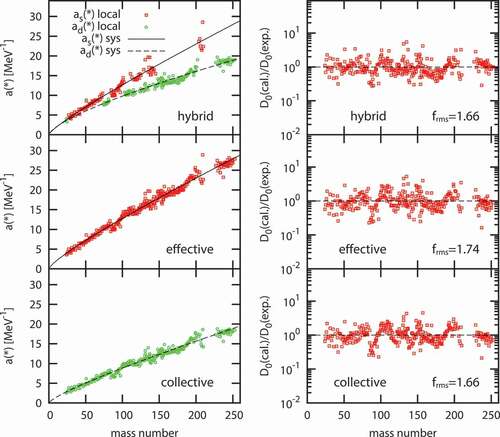
The hybrid model has an additional parameter that adjusts the width parameter
of
. While we use the theoretical values for the central energy
of
, the width parameter
that expresses a smoothness of the transition is quite phenomenological. Therefore, we investigated the dependence on
in the calculation of
. In ,
as a function of
is shown. While it is clear that a small
is not preferable,
dependence of
is so moderate in lager
region, which means that
cannot be a strong constraint on
. Basically, we used
that is smaller than the optimal value for
that is around 0.70, since a better agreement between calculations and experimental data of the nuclear reaction cross sections was obtained with
, in the case of (n, 2n) reactions for Se isotopes discussed in the next section.
We also optimized the parameters for the effective and the collective LD models. For these models, all the experimental values for 300 nuclei are used for the optimization of
. The obtained
and
for the effective and the collective models are shown in the middle and the bottom panels of , respectively, and the parameters in
and
calculated using the optimized
are listed in . Although significantly different parameters are required for
and
, the resulting
are similar among the effective, collective, and hybrid models. As already mentioned in the introduction, the essentiality of the explicit treatment of the collective enhancement is hardly seen in the calculation of
, if the phenomenological LD models optimized using the experimental
are used.
Finally, the parameters in the constant temperature part of LD are optimized. The parameters to be optimized are and
in EquationEquation (17
(17)
(17) ) to calculate
. They are determined to minimize
calculated with the same equation as EquationEquation (23
(23)
(23) ) using
and
, and
is determined to minimize
where is the cumulative number of the discrete levels at the excitation energy
of the experimentally observed ith level, and
is the number of levels to be compared. The experimental data of the discrete levels are taken from RIPL-3 database [Citation21]. Since there may be discrete levels that have not been observed, the cumulative number of the observed levels is expected to deviate from the reality with the increase in the excitation energy. We assume that the deviation is small if the cumulative number of the observed levels is much smaller than the maximum number of the observed levels and arbitrarily take 70% of the maximum number as
. Nuclei with more than 100 observed levels are used to determine the parameters of
. In , the obtained
and
are shown by the symbols and the solid line, respectively. It is seen that
are roughly reproduced by the mass dependence of
, except for the values around
. We take priority to achieve better precision for
in
region, which are relevant to the nuclear reaction calculations in the next section, and excluded
in
region from the fitting for this preference. In the final results presented in the next section, the optimized
is used to calculate LD.
Figure 5. Pairing corrected matching energy obtained by minimizing
of each nucleus and
calculated by EquationEquation (23
(23)
(23) ) are shown by the symbols and the solid line, respectively. The red symbols are results for even-even nuclei, and the green ones for odd and odd-odd nuclei.
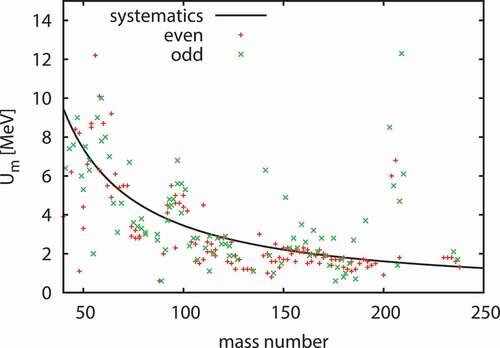
2.5. Nuclear reaction models
The nuclear reaction calculations have been executed using CCONE code [Citation16]. The code is composed of the optical model, two-component exciton model, distorted-wave Born approximation, and Hauser-Feshbach statistical model. As for the optical model, the global optical potential parameters of Koning and Delaroche [Citation22] were used. LDs of the hybrid, effective, and collective models are adopted to Hauser–Feshbach statistical model in CCONE code by using the tabulated numerical data of RIPL-3 format [Citation21].
3. Results
3.1. Total level densities
Before showing the results of the nuclear reaction calculations, the characteristics of the hybrid model are discussed from the total LDs in comparison with the effective and collective models. In , the total LDs of Se,
Zr,
Tm, and
Au in wide excitation energy range and those magnified around the neutron threshold are shown in the left and right panels, respectively. The parameters relevant to the deformation that determine the characteristic of the present hybrid model are summarized in . As described by EquationEquations (1
(1)
(1) ) and (Equation2
(2)
(2) ), the transition to
from
is made by these parameters. Hereafter, we denote the LDs of the hybrid, effective, and collective models as
,
, and
, respectively.
Table 2. Calculated ,
,
, and
of
Se,
Zr,
Tm, and
Au. The experimental values of the one neutron separation energies are also shown
Figure 6. Total level densities of the hybrid (solid line), effective (dashed line), and collective (dotted line) LD models for Se,
Zr,
Tm, and
Au as a function of
(left panel) and
(right panel) .
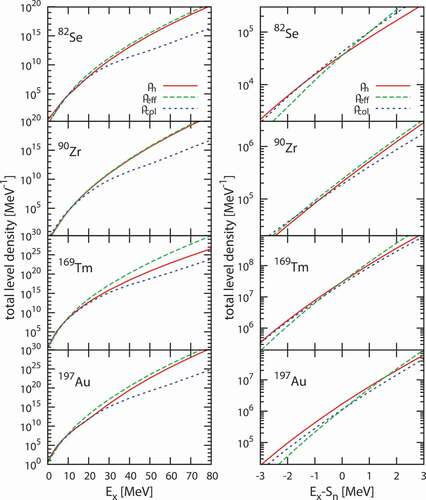
First of all, for the spherical Zr case,
is close to
in the entire region, while
is significantly different from them, because there is the rotational collective enhancement even in the spherical nuclei with the fixed
of 30 MeV. In addition to that, because of the difference in the asymptotic LD parameters, the increase rate of
above 30 MeV is also different from
and
. As for
Tm that has a developed deformation with
,
shows a similar behavior to
below about 30 MeV. They deviate from each other above 30 MeV, because the rotational collective enhancement fades in
around this energy but does not in
. As for
Se that has a moderately developed deformation of
, the component of
in
is decreasing around
= 7.5 MeV. In
MeV,
comes closer to
, because the component of
dominates in this region. The difference between
and
in the asymptotic region is characterized with the energy shift by
.
Au has a smaller
of 0.13 but has a larger
than
Se. The increment of
significantly reduces around
= 13 MeV because the difference between the spherical LD shifted by
and the deformed LD is large. Above 20 MeV, the increase rate of
comes closer to
and deviates from
.
The LDs around the neutron threshold are shown in the right panel of as a function of
. Since the asymptotic LD parameters are optimized for all of
,
, and
using the experimental
, they are close to each other at
. However, there is a difference in the increase rate of these LDs. In any case,
has a larger increase rate than
. Whether the increase rate of
is similar to that of
or
is determined by the deformation. It is close to
for the spherical
Zr and
for the deformed
Tm and
Au. As for
Se,
has even smaller increase rate than
, because the component of
disappears just around
in this case. The increase rates of LDs around
have remarkable influences on the nuclear reaction calculations explained in the next subsection.
3.2. Cross sections of (n, xn) and (p, xn) reactions
In this section, we test the effectiveness of LDs and also discuss the role of the rotational collective enhancement from the calculations of (n, xn) and (p, xn) reactions. The experimental data of the cross sections to be compared are taken from EXFOR [Citation23] throughout this section.
To illustrate the role of the rotational collective enhancement, the (n, 2n) and (n, 3n) reactions with Zr and
Tm targets that are spherical and deformed, respectively, are calculated. In addition to that, these nuclei have a plenty of (n, 2n) experimental data to be compared. There are also (n, 3n) experimental data for
Tm but not for
Zr. Instead, the (n, 3n) cross sections of
Y are calculated.
The results are shown in . As discussed in the previous subsection, is similar to
if the nucleus is spherical. Therefore, for the
Zr target, the (n, 2n) cross sections calculated using
and
are also similar, and they show good agreement with the experimental data. However,
is different from them even for the spherical
Zr and cannot reproduce the experimental data. For the deformed
Tm target, the cross sections calculated with
are similar to those with
. Compared to the results with
, the (n, 2n) and (n, 3n) cross sections are suppressed below 12 and 25 MeV, respectively. The (n, 3n) cross sections and the competing (n, 2n) cross sections above 15 MeV show good agreement with the experimental data. The difference in the calculated (n, 2n) cross sections mainly come from the difference in the LDs of the target nuclei. In the (n, 2n) reaction, first the
compound nucleus is formed and then it emits one neutron. In this process, if difference of LDs between lower and higher excited states is small, decays into higher excited states are relatively quenched, and the portion of decays into lower excited states increases. Therefore, if LD of the target nucleus has a small increase rate around the neutron threshold, decays into states under threshold increase, which means the increase of the competitive inelastic channel cross section and decrease of the (n, 2n) cross section. This also means that the emitted neutron tends to bring more energy. Later, the difference in the neutron emission spectrum is discussed in detail.
Figure 7. Cross sections of (n, 2n) reactions for Zr and
Tm and (n, 3n) reactions for
Y and
Tm. Calculated results using
,
, and
are shown by solid, dashed, and dotted lines, respectively. They are compared with the experimental data taken from EXFOR shown by symbols.
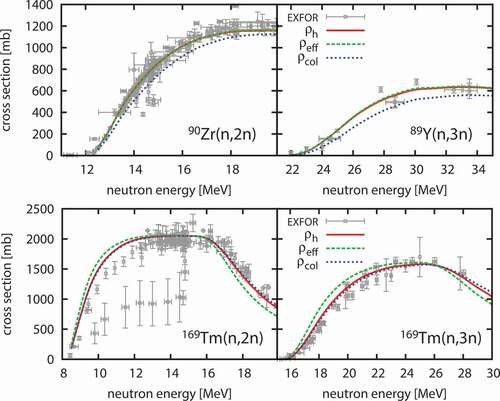
Next, we discuss the (n, 2n) cross sections of Se isotopes shown in . If the target nucleus has a moderate deformation with close to
, the (n, 2n) cross section calculated with
shows nonnegligible dependence on
, which is the width parameter of
.
Se,
Se,
Se, and
Se have
= 12.2, 11.1, 10.1, and 7.5 MeV, and
= 11.1, 10.5, 9.9, and 9.3 MeV, respectively. The (n, 2n) cross sections calculated with
and
show suppression from those with
, as in the cases of
Zr and
Tm. As for the results with
, the degrees of the suppression depend on
. The results calculated using
0.35 and 0.70 are also compared in . If
is smaller, a decrease of the component of
in
is more rapid, which results in a smaller increase rate of LD. Therefore, the (n, 2n) cross sections calculated with
tend to be suppressed compared to those with
. While this effect is not significant for
Se,
Se, and
Se cases, a noticeable difference is found for
Se, because
Se has
just below
. In this case, the component of
becomes zero just around
if
is used, which results in the significantly small increase rate of LD around
as shown in . As for
Se, the (n, 2n) cross sections calculated with
are even smaller than those calculated with
.
Figure 8. Cross sections of (n, 2n) reactions for Se isotopes. Calculated results are same as in except for the result using with
0.70 shown by dash-dotted line. The experimental data of Frehaut et al. are renormalized by a factor of 1.08 [Citation25] (circle).
![Figure 8. Cross sections of (n, 2n) reactions for Se isotopes. Calculated results are same as in Figure 7 except for the result using ρh with C=0.70 shown by dash-dotted line. The experimental data of Frehaut et al. are renormalized by a factor of 1.08 [Citation25] (circle).](/cms/asset/aceab231-6fd7-4c92-8f6a-29cba59d41dd/tnst_a_1588801_f0008_oc.jpg)
These results indicate that the effect of the fading of the rotational collective enhancement around can be seen in the (n, 2n) cross section. The validity of this effect should be studied using as many experimental data as possible, but not so many (n, 2n) experimental data are available for nuclei that have
close to
. Although the number of experiments is limited, Se isotopes have the systematic experimental data of Frehaut et al. [Citation24]. The calculated results with
well agree with those data renormalized by the factor of 1.08, which is derived by Vonach et al. [Citation25].
Another nucleus that has a plenty of experimental data and a moderate deformation is Au. The calculated results of
Au(n, xn) cross sections are shown in . As discussed in the case of Se isotopes, the values of
and
are important to understand the characteristics of the cross section calculated with
.
is 13 MeV for
Au, while
and
are 6.6 and 15.0 MeV, respectively. Since
is much larger than
and just below
, both (n, 2n) and (n, 3n) cross sections show suppression from the results with
below 14 and 25 MeV, respectively. However, the (n, 2n) and (n, 3n) cross sections in 15 MeV
25 MeV, which are competing, show a disagreement with the experimental data. To investigate how the calculated cross sections depend on the degrees of the deformation, a modified
for
Au that has arbitrarily chosen
and
values of 8 and 1 MeV is used to calculate the cross sections. The results are also shown in . Since
MeV is well under
, the suppression of the (n, 3n) cross sections below 25 MeV is small. As a consequence, the results with the modified
show a better agreement with the experimental data in 15 MeV
25 MeV. As for the (n, 4n) and (n, 5n) cross sections, the results with both
of
= 8 and 13 MeV are similar, because the incident energies are higher enough from
for these channels, which means the complete disappearance of the component of
. The results with
significantly deviate from those with
in the higher incident energy region due to the difference of LDs in the asymptotic region. Several experimental data above 40 MeV support the results with
.
Figure 9. Cross sections of (n, xn) reactions for Au. Calculated results are same as in except for the result using
with
= 8 MeV shown by dash-dotted line.

The suppression of (n, xn) cross sections calculated with and
from those with
is related to the difference in the evaporated neutron emission spectrum. To show this, the neutron emission spectrum of
Se(n, xn)
Zr(n, xn), and
Au(p, xn) reactions are calculated. The results are shown in the left panel of . The neutron emission spectrum of
Zr(n, xn) reaction at 14.1 MeV calculated with
shows a noticeable enhancement around 5 MeV from those calculated with
and
and a disagreement from the experimental data. It is consistent with the (n, 2n) cross section calculated with
, which significantly deviates from the experimental data. Since
has a smaller increase rate at a excitation energy close to the incident nucleon energy than
and
as seen in , the compound nucleus tends to decay into lower excited states and the emitted neutron brings a larger energy in the result with
compared to others. In most cases,
has a smaller increase rate than
, even for spherical nuclei. In
Se(n, xn) case, the calculated result with
is similar to
, which show enhancement from the result with
around 5 MeV.
Figure 10. Neutron emission cross sections of (n, xn) and (p, xn) reactions. Calculated results are same as in . The experimental data are taken from EXFOR.
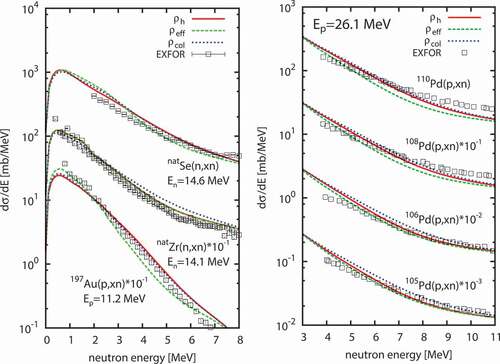
In the right panel of , the neutron emission spectrum of Pd(p, xn) reactions at
MeV are shown. For
Pd,
Pd,
Pd, and
Pd,
are calculated to be 11.0, 14.3, 18.0, and 20.3 MeV, respectively. While all of four Pd isotopes have moderate deformations around
, the difference in
results in the significant difference in the evaporated neutron emission spectrum. Since
Pd has the largest
that is close to
, the component of
in
affects the neutron emission from the compound nucleus. In this case, the neutron emission spectrum calculated with
is close to
and deviates from that with
. If
is much smaller than
, the component of
has a small influence on the neutron emission from the compound nucleus. Therefore, the neutron emission spectrum calculated with
is similar to that with
in
Pd(p, xn) and
Pd(p, xn) cases. This result illustrates the characteristic of the present LD model and, at the same time, the role of the collective enhancement in the evaporated neutron emission spectrum.
4. Summary
To construct a new phenomenological LD model for a better precision of the nuclear reaction calculation, and to investigate the role of the rotational collective enhancement in the nuclear reaction at the same time, we proposed the hybrid model in which the LDs of the deformed and the spherical states described by the Fermi gas model are connected by the damping function. We optimized the asymptotic LD parameter systematics for the LDs of the deformed and the spherical states separately using the experimental of deformed and spherical nuclei, respectively. The information of the nuclear deformation derived from the FTHFB calculation was utilized. The obtained LD was introduced in the nuclear reaction calculation using the statistical model, and the cross sections of (n, xn) and (p, xn) reactions were discussed.
We found that the LD with the rotational collective enhancement tends to have a smaller increase rate compared to that with no explicit collective enhancement, which results in a higher energy neutron emission from the compound nucleus. The (n, xn) cross sections with incident neutron energies just above the threshold are suppressed because of this mechanism. In many cases, cross sections calculated with the transitional model were similar to those with the effective model and the collective model for the nuclear reactions for the spherical and the deformed targets, respectively. We showed the calculated examples for the spherical Zr and the deformed
Tm targets, both of which agree with the experiments.
Depending on the incident nucleon energy and the degree of the deformation of the target nucleus, the cross sections have sensitivity to a certain energy range of LD where the component of the deformed state is decreasing. In Se(n, 2n) reactions, the decreasing component of the deformed state results in a good agreement between the calculated and the experimental cross sections. In
Au(n, xn) reactions, how cross sections depend on the degrees of the deformation was shown. These results indicate that a more reliable prediction of deformations in excited states may lead to a more precise calculation of cross sections.
These results indicate that the present model is effective for precise calculations of nuclear reactions for both the spherical and deformed targets. Since the calculated cross section depends on the predicted deformations, a more precise cross section calculation can be achieved with a more reliable nuclear structure calculation in future. This model also can be a tool to investigate the fading of the rotational collective enhancement in nuclear excited states through the nuclear reaction calculation.
Disclosure statement
No potential conflict of interest was reported by the authors.
Additional information
Funding
References
- Gilbert A, Cameron AGW. A composite nuclear level density formula with shell corrections. Can J Phys. 1965;43:1446.
- Mengoni A, Nakajima Y. Fermi-gas model parametrization of nuclear level density. J Nucl Sci Technol. 1994;31:151–162.
- Koning AJ, Hilaire S, Goriely S. Global and local level density models. Nucl Phys A. 2008;810:13–76.
- Ignatyuk AV, Istekov KK, Smirenkin GN. Role of collective effects in the systematics of nuclear level densities. Sov J Nucl Phys. 1979;29:450.
- Goriely S. A new nuclear level density formula including shell and pairing correction in the light of a microscopic model calculation. Nucl Phys A. 1996;605:28–60.
- Demetriou P, Goriely S. Microscopic nuclear level densities for practical applications. Nucl Phys A. 2001;695:95–108.
- Minato F. Nuclear level densities with microscopic statistical method using a consistent residual interaction. J Nucl Sci Technol. 2011;48:984–992.
- Hilaire S, Delaroche JP, Girod M. Combinatorial nuclear level densities based on the Gogny nucleon-nucleon effective interaction. Eur Phys J A. 2001;12:169–184.
- Hilaire S, Goriely S. Global microscopic nuclear level densities within the HFB plus combinatorial method for practical applications. Nucl Phys A. 2006;779:63–81.
- Goriely S, Hilaire S, Koning AJ. Improved microscopic nuclear level densities within the hartree-fock-bogoliubov plus combinatorial method. Phys Rev C. 2008;78:064307.
- Hilaire S, Girod M, Goriely S, et al. Temperature-dependent combinatorial level densities with the D1M Gogny force. Phys Rev C. 2012;86:064317.
- Bour A, Mottelson BR. Nuclear structure vols I and II. New York: W. A. Benjamin Inc; 1969, 1975.
- Shibata K, Osamu I, Tsuneo N, et al. JENDL-4.0: A new library for nuclear science and engineering. J Nucl Sci Technol. 2011;48:1.
- Junghans AR, M DJ, Clerc H-G, et al. Projectile-fragment yields as a probe for the collective enhancement in the nuclear level density. Nucl Phys A. 1998;629:635.
- Hansen G, Jensen AS. Energy dependence of the rotational enhancement factor in the level density. Nucl Phys. 1983;406:236.
- Iwamoto O, Iwamoto N, Kunieda S, et al. The CCONE code system and its application to nuclear data evaluation for fission and other reactions. Nucl Data Sheets. 2016;131:259–288.
- Myers WD, Swiatecki WJ. Nuclear masses and deformations. Nucl Phys. 1966;81:1.
- Mughabghab SF, Dunford C. Nuclear level density and the effective nucleon mass. Phys Rev Lett. 1998;81:4083.
- Stoitsov MV, Schunck N, Kortelainen M, et al. Axially deformed solution of the skyrme-hartree-fock-bogoliubov equations using the transformed harmonic oscillator basis (II) HF BTHO v2.00d: A new version of the program. Comp Phys Commun. 2013;184:1592–1604.
- Bartel J, Quentin P. Towards a better parametrisation of Skyrme-like effective forces: a critical study of the SkM force. Nucl Phys A. 1982;386:79–100.
- Capote R, Herman M, Obložinský P, et al. RIPL - reference input library for calculation of nuclear reactions and nuclear data evaluations. Nucl Data Sheets. 2009;110:3107–3214.
- Koning AJ, Delaroche JP. Local and global nucleon optical models from 1 keV to 200 MeV. Nucl Phys A. 2003;713:231–310.
- Otuka N, Dupont E, Semkova V, et al. Towards a more complete and accurate experimental nuclear reaction data library (EXFOR): international collaboration between nuclear reaction data centres (NRDC). Nucl Data Sheets. 2014;120:272–276.
- Frehaut J, Bertin A, Bois R, et al. Status of (n, 2n) cross section measurements at bruyeres-le-chatel. In: Bhat MR, Pearlstein S, editors. Proceedings of symposium on neutron cross-sections from 10 to 50 MeV. Upton (NY): Brookhaven National Laboratory; 1980 May 12–14. p. 399–411.
- Vonach H, Pavlik A, Strohmaier B. Accurate determination of (n, 2n) cross sections for heavy nuclei from neutron production spectra. Nucl Sci Eng. 1990;106:409–414.

